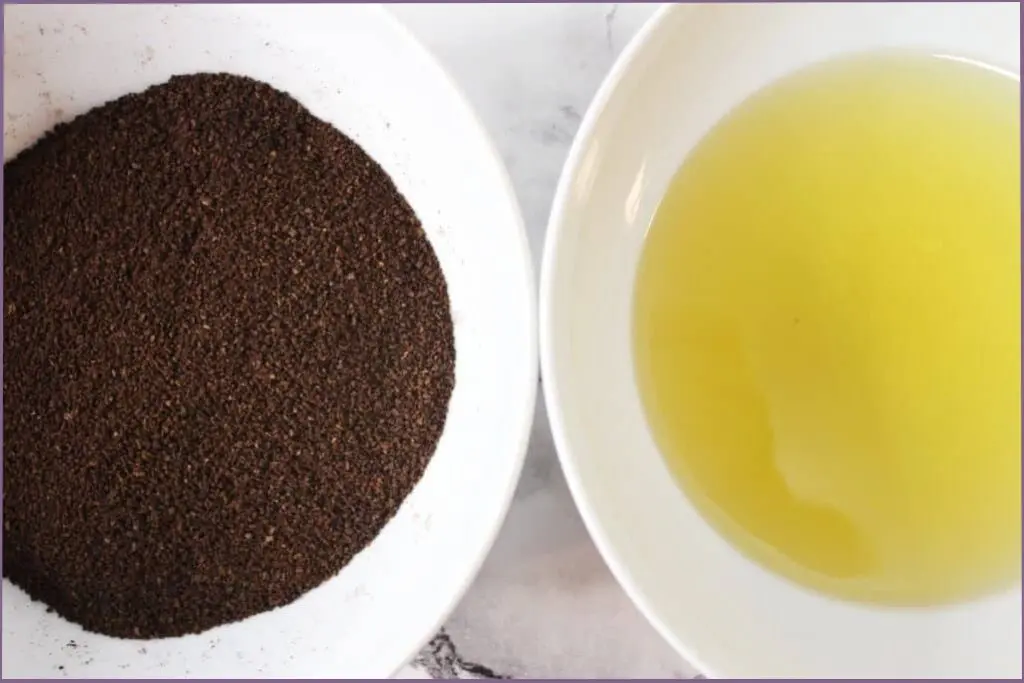As an Amazon Associate I earn from qualifying purchases. See Full Disclosure Here
Coffee-infused oil is a flavorful infusion created by steeping coffee grounds in a carrier oil. This process transfers the rich aroma and taste of coffee to the oil, creating a unique infusion with a variety of uses, primarily in DIY skincare products.

Coffee oil is believed to have antioxidant properties that may benefit the skin, potentially aiding in reducing inflammation and puffiness.
It’s important to note that while some find coffee-infused oil beneficial for skin, it’s always recommended to consult a dermatologist before using any homemade product on your skin, especially if you have any sensitivities.
Benefits of Making Your Own Coffee Infused Oil
There are several advantages to making your own coffee-infused oil at home.
First, you have complete control over the ingredients. You can choose high-quality carrier oils and freshly ground beans to ensure the best flavor and potential benefits.
Second, it’s a cost-effective way to create a unique skincare product with that delicious heady aroma.
Finally, the infusing process is simple yet immensely rewarding, allowing you to experiment with different flavors and personalize the final product to your taste.
What You Need To Make Coffee Infused Oil

You need just two ingredients
- 1 cup carrier oil
- ½ to ¾ cup ground coffee
In addition, you’ll also need
- A mesh can lid for straining the infusion or a regular strainer
- A glass jar
- 4 ounce dropper bottle (optional)
This makes about 8 ounces.
Choosing Your Ingredients
Carrier Oil
The carrier oil serves as the base for the infusion and plays a significant role in the final flavor and application. These are some factors to consider when choosing your carrier oil:
Neutral oils: Grapeseed, almond, and avocado oils are neutral and have mild aromas that allow the java aroma to shine through.
Olive oil: Extra virgin olive oil has its own characteristic flavor profile that is quite strong and can overpower the coffee aroma.
Coffee Beans

For the best results, use freshly ground beans. Pre-ground coffee tends to have a weaker flavor and aroma. Here’s how coffee selection can impact your infusion:
Grind: A medium grind is ideal. Too fine a grind can make straining difficult, while a coarse grind may not release as much flavor.
Roast: Lighter roasts tend to have brighter, more floral notes that can translate well into the oil. Darker roasts will impart a bolder, richer aroma.
Additional considerations: Choosing organic coffee beans and organic carrier oil ensures minimal exposure to pesticides and chemicals.
By considering these factors, you can select the perfect carrier oil and beans to create a bold or mild coffee-infused oil according to your preference.
Infusion Methods
There are two main methods for infusing coffee beans in oil: cold infusion and hot infusion. Each method offers its own advantages and results in a slightly different flavor profile.
Cold Infusion or Steeping
Place the medium coffee grounds into a clean glass jar.
Pour the avocado oil into the jar. It will take some time as the viscous liquid slowly makes its way down the grounds. Make sure you add sufficient carrier oil so that it covers the grounds completely.
Label the infusion jar with ingredients and date.
Close the lid tightly and store it in a cool, dark place.
Leave for a few weeks or months to let the aroma from the coffee grounds slowly infuse into the oil.
Infusion Time: The ideal steeping time can vary depending on your preference. Start with 2 weeks. If you want a stronger flavor, extend the steeping time for another week or two.
Strain the infusion with a wire mesh strainer. Use a cheesecloth strainer if you want a smooth end product without any bits of ground.
Pour the infused oil in a glass jar or dropper bottle.
That’s it! Your homemade coffee infused oil is now ready to use.
Cold infusion is a slower process but offers a couple of advantages. Potentially stronger flavor due to the longer extraction time.
Hot Infusion (Double Boiler Method)

The hot infusion method utilizes a double boiler to gently heat the oil and coffee grounds, accelerating the infusion process.
Add your chosen carrier oil and grounds into a heat-resistant jar. Place the jar into a pot for the double boiler.
If you don’t have a double boiler here’s how to create one at home. Fill a saucepan with a few inches of water and place the jar or container on top, ensuring it doesn’t touch the bottom of the pan.
Heat the water on medium-low, maintaining a gentle simmer.
Strain the infusion with a wire mesh strainer. Use a cheesecloth strainer if you want a smooth oil without any coffee bits.
Put the infused oil in a glass jar or dropper bottle. Make sure the oil is completely cooled down before storing.
Infusion Time: Infuse the oil for 4-7 hours, stirring occasionally. DO NOT turn up the heat during this time.
You can adjust the time based on your desired aroma intensity.
Pros: This method is significantly faster, typically taking 4-7 hours compared to cold infusion’s weeks.
Choosing the Infusion Right Method
If you’re short on time the hot infusion method is a good choice. Be careful to keep the temperature low at all times so the oil does not burn.
The cold infusion method is a better alternative if you’re looking for a stronger java aroma and less risk of burning. However, be prepared to wait a couple of weeks for the infusion to be ready.
Whatever infusion method you choose, proper hygiene during preparation is of utmost importance. Wash your hands thoroughly before touching any of the ingredients and sterilize all equipment and jars to prevent introducing bacteria that can cause skin infections.
Straining and Storage Tips
Once the desired aroma intensity is achieved, it’s time to separate the grounds from the oil. Here’s how to properly strain and store your creation.
Straining Tips
There are two primary methods for straining your infused oil:
Cheesecloth: Line a fine-mesh sieve with several layers of cheesecloth. Pour the infusion through the cheesecloth. The liquid will pass through leaving behind the unwanted solid particles. Squeeze the cheesecloth gently to extract any remaining oil.
Coffee Filter: While cheesecloth is generally a better option, you can use a coffee filter in a pinch. Be aware that a coffee filter may allow the finer pieces to pass through, resulting in a slightly cloudy product.
Additionally, coffee filters tend to absorb more oil compared to cheesecloth, so you may lose a bit of your precious infused oil.
Storage Tips
To preserve the quality and flavor of your infusion, follow these storage guidelines:
Store in a Dark, Cool Place: Light and heat can degrade the oil, so store your homemade creation in a cool, dark cupboard or pantry away from direct sunlight or heat sources.
Use an Airtight Container: Use a sterilized, airtight container, such as a dark glass jar with a tight-fitting lid. This will prevent air exposure, which can accelerate spoilage.
Watch the Shelf Life: The shelf life of your coffee-infused oil depends on the chosen carrier oil and storage conditions. Generally, well-stored infused oil can last for up to 3 months. Here are some additional factors to consider:
Carrier Oil: Some carrier oils, such as avocado oil, have a longer shelf life than others such as olive oil.
Freshness of Ingredients: Using fresh, high-quality coffee beans and carrier oil will contribute to a longer shelf life.
Spoilage Signs: It’s important to check your infused oil for spoilage before using it. Signs of spoilage include a rancid odor, cloudiness, or a change in color. Discard the product if you notice any of these signs.
Benefits Of Coffee-Infused Oil For Hair + How To Use
Coffee-infused oil is a rich source of caffeine which helps stimulate and nourish the scalp, boost hair growth, strengthen hair, and prevent hair fall and breakage.
To use, massage a small amount into your scalp before shampooing, focusing on the roots. Leave it on for 30 minutes to an hour for deeper penetration.
You can also use it as a leave-in conditioner by applying a very small amount to the ends of damp hair, avoiding the roots to prevent greasy buildup.
Remember, a little goes a long way with coffee-infused oil. It’s always best to start with a small amount and see how your hair reacts. If you experience any scalp irritation, discontinue use.
If you have any pre-existing scalp conditions, it’s advisable to consult a dermatologist or trichologist (hair specialist).
How To Use Homemade Coffee-Infused Oil for Skin Directly & Indirectly

Face Massage: Dilute the infusion with carrier oil such as sweet almond oil, apply to the face, and massage gently in circles. Leave it on for 15–30 minutes, then rinse with warm water. Avoid if you have dry skin.
The delightful aroma of coffee can elevate your DIY bath and body products, creating a spa-like experience without directly applying it to your skin. This will allow you to enjoy that energizing aroma and get the benefits of coffee oil for skin without the drying effect.
Here are some creative ways to use homemade coffee infused oil for skin indirectly:
Scented Bath Bombs: Craft bath bombs that fizz and release a burst of coffee fragrance. Add a few drops of the infusion for a subtle scent and conditioning properties for your bath. This is so much better than adding grounds directly, which can be messy and leave a residue.
Whipped Body Butter: Coffee-scented whipped body butter can be a luxurious treat for any skin type. Adding a few drops will give the body butter a subtle coffee scent without compromising its quality.
Infused Bath Salts: Elevate your bath experience with homemade coffee-infused bath salts. Combine your favorite bath salts like Epsom salts or Dead Sea salts with a few drops of your homemade infusion.
Lip Scrub: Combine brown sugar or another gentle exfoliant with a carrier oil suitable for lips, such as sweet almond oil or jojoba oil. Add a drop or two of coffee oil. This provides a delightful coffee aroma without the potential irritation of applying harsh coffee grounds on the delicate lip area.
Exfoliating Scrub: The grounds act as a natural exfoliant, while the oil provides a moisturizing base. Create a DIY coffee scrub by mixing finely ground coffee beans with your homemade infusion. Limit application to areas like the elbows, knees, and feet, avoiding the delicate facial skin.
Lip Balm (with Caution): The moisturizing properties of the carrier oil and the potential plumping effect of coffee might seem like a good fit for lip balm. However, caffeine can be irritating to some people’s lips. If you have sensitive lips, this is definitely not recommended. It’s also important to ensure proper hygiene during preparation to avoid introducing bacteria.
DIY Melt and Pour Soap: Coffee-infused oil can be a delightful addition to your DIY melt and pour soap creations. Adjust the melt and pour soap recipe, substituting the recommended carrier oil with coffee infused oil. For an added visual and textural touch, sprinkle finely ground beans on top of the soap.
Precautions When Using Coffee-Infused Oil on Skin
Here’s a breakdown of the key precautions to consider:
Skin Irritation: Coffee itself can irritate sensitive skin, causing redness, itching, or burning. A dermatologist can assess your skin type and advise if this infusion is appropriate for you.
Patch Test: Always perform a patch test before applying any new product to your face or larger areas of skin. Apply a small amount to the inner arm and wait 24-48 hours. Discontinue use if you experience any irritation.
Sun Sensitivity: Certain skincare ingredients can increase sun sensitivity. While the effect of coffee on sun sensitivity isn’t definitively established, it’s wise to consult a dermatologist to be sure, especially if you use medications or have existing skin conditions that affect sun sensitivity.
Carrier Oil Selection: Choose a carrier oil suitable for your skin type. For example, grapeseed oil is lighter and may be better for oily or combination skin, while avocado oil is richer and may be better for normal or dry skin (consult a dermatologist for specific recommendations).
Fragrance: The strong coffee scent can be overpowering for some people. If you have fragrance sensitivities, you be careful about applying any scented products.
Pre-existing Skin Conditions: If you have any pre-existing skin conditions like eczema or rosacea, consult a dermatologist before using coffee-infused oil. They can advise on safe alternatives or recommend store-bought products formulated for your specific needs.
When in doubt, prioritize safety. Consulting a dermatologist can give you peace of mind and ensure you’re using skincare products that are safe and effective for your unique needs.
Coffee Infused Oil Is Not Coffee Essential Oil
Infused oil is distinct from essential oil. There is no such thing as coffee essential oil.
Essential oils are highly concentrated, volatile liquids extracted from plants through processes such as steam distillation. Coffee beans, however, don’t contain enough volatile compounds to be suitable for essential oil extraction.
Coffee-infused oil on the other hand, is created by steeping coffee grounds in a carrier oil, transferring the coffee’s flavor and aroma to the oil.
Related Reads:
How to make calendula-infused oil
Disclaimer: This information is not intended to serve as medical advice. Please consult your doctor before using any natural medication or if you experience any unusual symptoms. See Full Disclaimer here.









